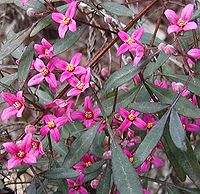Boronia
| Boronia subsp. var. | ||||||||||||||||||||||||||||||||||||||||||||||||||||||||
|---|---|---|---|---|---|---|---|---|---|---|---|---|---|---|---|---|---|---|---|---|---|---|---|---|---|---|---|---|---|---|---|---|---|---|---|---|---|---|---|---|---|---|---|---|---|---|---|---|---|---|---|---|---|---|---|---|

|
|
| ||||||||||||||||||||||||||||||||||||||||||||||||||||||
| ||||||||||||||||||||||||||||||||||||||||||||||||||||||||
Boronia is a genus of about 90-100 species of evergreen shrubs of the tribe Boronieae in the family Rutaceae. They are found all over Australia.
Boronias generally grow in open forests and woodlands. They are only rarely found in rainforests or arid areas, though some unusual species have recently been described from the northwest of Western Australia.
| Standard Cyclopedia of Horticulture |
|---|
|
Boronia (after Francis Borone, an Italian who lost his life at Athens in the service of Dr. Sibthorp). Rutaceae, Greenhouse shrubs, interesting, and very fragrant. Boronia is a genus of Australian shrubs with numerous fls., having a rue-like fragrance: Lvs. opposite, odd- pinnate, or simple: fls. axillary and terminal, red, rarely white or purplish, on the plan of 4, bearing a thick entire dusk: fr. 2-4 carpels, each 1- or 2-seeded. B. megastigma and its allies, B. elatior and B. heterophylla, are remarkable for their very large stigma (which is 4-lobed at the base), and their curious stamens, 4 of which are small, yellow, pollen-bearing, and hidden under the stigma, while the 4 large, conspicuous ones are dark purple or black, and bear no pollen.—About 60 species, in Australia. The chief value of boronias is their delicious fragrance. A small specimen will perfume a whole house for two or three weeks. Boronias are cultivated like Cape heaths in a cool greenhouse. After flowering they should be cut back, in order to make compact, bushy specimens. The leading shoots may be frequently pinched, to prevent a straggling growth. As most of them are native of barren sandy places, not bogs, good drainage is necessary. "Sour" soil is very disastrous to them. The English florists set their young plants in the open ground during summer, being careful to shade them with lath frames. Plants that have flowered two seasons are thrown away and replaced by younger specimens. They are propagated by cuttings from half-ripened wood inserted in 4-inch pots, which are filled to within an inch of the top with a compost of finely sifted loam, peat and sand, over which is spread a layer of sharp sand. After a thorough watering, they may be placed under a bell-glass in a greenhouse in which the temperature ranges from 45° to 50° F., and shaded from right sunshine. Seeds germinate readily in the same temperature, and make good flowering plants in one season. Seeds can be obtained from German or Australian dealers, large quantities being collected in the wild. Boronias belong to a large class of hard-wooded Australian plants that were popular along with the Cape heaths in the early part of the nineteenth century. These were largely replaced by quicker-growing, soft-wooded plants. The renewed interest in boronias is largely due to the more recently introduced species, of which the first three described below are the best. American florists have lately grown them somewhat for Easter, especially B. helerophylla. Many species are likely to be introduced, as these shrubs are very brilliant in Australia, blooming when very young, and remaining attractive for two or three months. B. denticulata, Smith. 2-6 ft.: Lvs. mucronate, denticulate: fle. in peduncled corymbs, rose-purple.—B. Fraseri, Hook. (B. anemonifolia, Paxt.). 1-3 ft.: lvs. trifid, the wedge-shaped segms. entire or 2-3-toothed: fls. axillary, solitary, pink. New Holland. P.M. 9:123.—B. pulchella, Turcz. (B. Drummondii, Planch.). 2 ft.: lvs. pinnatifid: fls. rose-pink, freely produced in spring and summer. Var. alba. A white-fld. form is known. F. S. 9:881.
|
Cultivation
Boronias are known for their perfumed flowers, especially B. megastigma. Unfortunately, they are generally somewhat difficult to grow in cultivation. All species require excellent drainage and part shade.
Propagation
- Do you have propagation info on this plant? Edit this section!
Pests and diseases
- Do you have pest and disease info on this plant? Edit this section!
Species
- Selected species
- Boronia clavata
- Boronia falcifolia
- Boronia fraseri
- Boronia imlayensis
- Boronia ledifolia
- Boronia megastigma
- Boronia microphylla
- Boronia mollis
- Boronia molloyae
- Boronia muelleri
- Boronia ovata
- Boronia pinnata
- Boronia safrolifera
- Boronia serrulata (Native rose)
Gallery
If you have a photo of this plant, please upload it! Plus, there may be other photos available for you to add.
